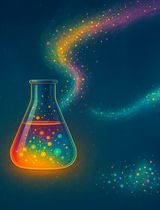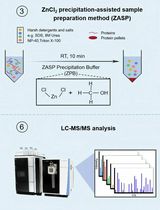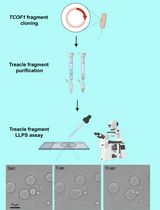- EN - English
- CN - 中文
Purification of Native Acetyl CoA Carboxylase From Mammalian Cells
从哺乳动物细胞中纯化天然乙酰辅酶A羧化酶
发布: 2025年02月20日第15卷第4期 DOI: 10.21769/BioProtoc.5221 浏览次数: 2151
评审: Komuraiah MyakalaAnonymous reviewer(s)

相关实验方案

适用于 LC–MS/MS 蛋白质组学分析的大体积细胞培养上清分泌组样品制备方法优化
Basil Baby Mattamana [...] Peter Allen Faull
2025年12月20日 1017 阅读
Abstract
Fatty acid (FA) biosynthesis is a crucial cellular process that converts nutrients into metabolic intermediates necessary for membrane biosynthesis, energy storage, and the production of signaling molecules. Acetyl-CoA carboxylase (ACACA) plays a pivotal catalytic role in both fatty acid synthesis and oxidation. This cytosolic enzyme catalyzes the carboxylation of acetyl-CoA to malonyl-CoA, which represents the first and rate-limiting step in de novo fatty acid biosynthesis. In this study, we developed a rapid and effective purification scheme for separating human ACACA without any exogenous affinity tags, providing researchers with a novel method to obtain human ACACA in its native form.
Key features
• Detailed protocol for the purification of native ACACA.
• ACACA is biotinylated in mammalian cells.
Keywords: ACACA (ACACA)Background
Acetyl-CoA carboxylase (ACACA) plays a pivotal catalytic role in both fatty acid synthesis and oxidation [1]. This cytosolic enzyme catalyzes the carboxylation of acetyl-CoA to malonyl-CoA, which is the first and rate-limiting step of de novo fatty acid biosynthesis. This process involves two steps: first, the ATP-dependent carboxylation of biotin, carried out by the biotin carboxylase (BC) domain; second, the transfer of the carboxyl group from carboxylated biotin to acetyl-CoA [2–4]. Mammals possess two acetyl CoA carboxylase (ACC) isoforms: ACACA, located in the cytosol of the liver and adipose tissues, and ACACB, associated with the mitochondrial outer membrane in heart and muscle tissues [5,6].
Recent developments in tumor fatty acid metabolism have provided new insights into potential therapeutic strategies for cancer. Studies have shown that tumor cells exhibit abnormal lipid metabolism reprogramming [7]. ACACA is often overexpressed in various tumor types, and elevated levels of its expression correlate with poor prognosis in cancer patients [8]. Further investigations have revealed that metabolic reprogramming can enhance the malignant progression of tumor cells by altering their ability to sense essential nutrients [9]. These findings underscore the critical role of metabolic reprogramming in tumorigenesis and development, highlighting it as a hallmark of malignant cells [10]. Currently, preclinical and clinical trials targeting lipid metabolism are ongoing [11–13]. In gastric cancer, the phosphorylated ACACA is closely associated with tumor cell behavior [14].
ACACA functions as a homodimer with an approximate molecular weight of 510 kDa, resulting from the dimerization of its carboxyl-terminal (CT) domain [4]. Eukaryotic ACACA comprises several structural domains: biotin carboxylase (BC), biotin carboxyl carrier protein (BCCP), and carboxytransferase (CT), along with the interacting structural domain (BT) and the non-catalytic central structural domain (CD), which connects the BC and CT domains. The CD contains four structural elements: the N-terminal CDN, the linking CDL, and the tandem C-terminal cell cycle protein-dependent kinases CDC1 and CDC2 [4].
ACACA represents a promising target for drug development aimed at treating tumor growth [4,15] and obesity-related diseases [16–18]. It also serves as a target site for various commercial herbicides [19]. In this study, we developed an efficient method to purify the recombinantly expressed human ACACA without affinity tags. Using this method to purify ACACA allows the isolation of endogenous proteins in a state closest to their natural conformation. This is particularly advantageous for structural and enzyme activity analysis of human ACACA proteins in their native states since a tag on a protein’s C or N terminus can sometimes bring side effects. Notably, this protocol eliminates the need for enzymatic cleavage of purification tags, thereby avoiding concerns about potential interference from exogenous labels on the folding and stability of the target protein. This protocol enables the purification of ACACA without the use of exogenous labels, preserving the protein’s natural structure. By avoiding the influence of labels on protein stability and folding, the method is highly advantageous for conducting functional experiments and structural analyses. Its simplicity and efficiency make it a valuable tool for researchers studying the behavior of ACACA in a native-like environment. This method offers several advantages. On one hand, it enables the purification of endogenous ACACA without the need for purification labels, preserving the protein in a state closest to its natural environment while eliminating the complex enzymatic tag-cleavage step that is typically required in labeled purification methods. On the other hand, by avoiding the use of affinity tags, researchers can directly utilize native tissues or cells to efficiently purify endogenous ACACA. This approach significantly saves time and energy, making it a streamlined and resource-efficient solution. However, we acknowledge that a limitation of purifying ACACA without exogenous labels is the difficulty in estimating the yield of ACACA from native tissues, as its expression levels can vary significantly across different tissues. This variability introduces uncertainty regarding the amount of tissue required to purify sufficient quantities of endogenous ACACA. In general, it is feasible to harness our method to purify endogenous ACACA.
Materials and reagents
Biological materials
1. DH10Bac competent cells (Shanghai WEIDI Biology, catalog number: DL1071S)
2. pBMCL1 plasmid (Addgene, catalog number: 178203) [20]
3. 293F cells (bio-83951)
4. Sf9 cells (bio-68378)
5. DH5α (Tian Gen Biology, catalog number: CB101)
6. 293 expression medium FreeStyleTM (Gibco, catalog number: 12338026)
7. Sf-900TM II SFM (Gibco, catalog number: 10902088)
8. Forward primer (Qing Ke Biology):
tgcctttctctccacaggtgtaaggaattcATGGATGAACCATCTCCCTTGGCCCAACC
Reverse primer:
ggctagcggccgcccgggatccTCACGTGGAAGGGGAATCCATTGT
Reagents
1. Tris (hydroxymethyl) aminomethane (Tris base) (VWR Life Science, catalog number: 0497-5KG)
2. StrepTactin beads 4FF (Smart-Lifesciences, catalog number: SA053100)
3. Yeast extract (Thermo Fisher, catalog number: LP0021B)
4. Tryptone (Thermo Fisher, catalog number: LP0042B)
5. NaCl (VWR Life Science, catalog number: 0241-10KG)
6. SDS (Sodium dodecyl sulfate) (VWR Life Science, catalog number: SA053100)
7. APS (Ammonium persulfate) (Biorigin, catalog number: BN20179)
8. TEMED (N,N,N',N'-Tetramethylethylenediamine) (Yuan Ye, catalog number: R21208)
9. 30% Acrylamide (NOVON, catalog number: SS0826)
10. Agar powder (NOVON, catalog number: zz14022)
11. Ampicillin (Lablead, catalog number: ST008)
12. Fetal bovine serum (FBS) (Gibco, catalog number: 26010074)
13. D-biotin (NOVON, catalog number: ST2051)
14. Sodium butyrate (Macklin, catalog number: S817488)
15. Protein ladder (Thermo Fisher, catalog number: 26619)
16. X-Gal (MedChemExpress, catalog number: HY-15934)
17. Coomassie Brilliant Blue (BioDee, catalog number: BN20720)
18. IPL-41 medium (Thermo Fisher, catalog number: 11405081)
19. Cellfectin 2 reagent (Thermo Fisher, catalog number: 10362-100)
20. HCl (Nan Jing Reagent, catalog number: C0680110228)
21. Protease inhibitors (Thermo Scientific, catalog number: A32965)
22. Na2ATP (NOVON, catalog number: MC0709)
23. MgCl2 (Macklin, catalog number: 7791-18-6)
24. Protein loading buffer (Beyotime, catalog number: P0015)
25. Sf9 medium (Gibco, catalog number: 10902088)
26. 293F FreeStyle medium (Gibco, catalog number: C12338018)
27. Kanamycin (Lablead, catalog number: K9316)
28. Gentamicin (MedChemExpress, catalog number: HY-A0276A)
29. Tetracycline (Lablead, catalog number: T9302)
30. Isopropyl-β-D-thiogalactopyranoside (IPTG) (Beyotime, catalog number: ST098)
31. Agarose (Yeasen, catalog number: CB005)
32. Glycerol (VWR, catalog number: 0167)
33. Agarose Gel Recovery kit (TIANGEN, catalog number: DP209)
34. P1, P2, P3 (TIANGEN, catalog number: DP105)
35. BamH1-HF (New England Biolabs, catalog number: R3136)
36. EcoR1-HF (New England Biolabs, catalog number: R3101)
37. Isopropanol (Macklin, catalog number: 67-63-0)
38. 75% ethanol (Macklin, catalog number: 64-17-5)
39. Phospho-ACC(Ser79) (Cell Signaling, catalog number: D7D11)
40. Horseradish peroxidase-labeled goat anti-rabbit IgG (H+L) (Beyotime, catalog number: A0208)
41. Methanol (Macklin, catalog number: 67-56-1)
42. Tween-20 (Merck, catalog number: P1379)
43. Skimmed milk powder (YiLi)
44. PVDF (Beyotime, catalog number: FFP80)
45. Chemiluminescent substrate (Thermo Scientific, catalog number: YK378690)
46. Acetyl CoA Carboxylase Activity Detection kit (Solarbio, catalog number: BC6020)
47. Seamless Cloning kit (Beyotime, catalog number: D7010M)
48. β-mercaptoethanol (β-ME) (Merck, catalog number: M3148)
49. n-Dodecyl-beta-D-maltoside (DDM) (Thermo Fisher, catalog number: 329370250)
50. CHS (Anatrace, catalog number: CH210)
51. Water (Hangzhou Wahaha Group)
52. Glycine (VWR Life Science, catalog number: 0167-5KG)
53. Na2EDTA·2H2O (Thermo Fisher, catalog number: 15576028)
Solutions
1. Lysis buffer (see Recipes)
2. Wash buffer (see Recipes)
3. Separation gel 8% (see Recipes)
4. Separation gel 10% (see Recipes)
5. Concentrated gel 5% (see Recipes)
6. LB medium (see Recipes)
7. Ampicillin LB agar plates (see Recipes)
8. Blue and white spot screening plates (see Recipes)
9. TBST (see Recipes)
10. 10× SDS-PAGE running buffer (see Recipes)
11. 50× TAE (see Recipes)
Recipes
1. Lysis buffer
50 mM Tris-HCl pH 8.0, 150 mM NaCl, 5% glycerol, 5 mM β-M), 1% DDM/CHS.
2. Wash buffer
50 mM Tris-HCl pH 8.0, 150 mM NaCl, 5 mM MgCl2, 5% glycerol, 5 mM β-M), 5 mM Na2ATP.
3. Separation gel 8%
7,050 μL of double-distilled water, 4,000 μL of 30% acrylamide, 3,800 μL of 1.5 M Tris-HCl (pH 8.8), 150 μL of 10% SDS, 150 μL of 10% APS, 9 μL of TEMED.
4. Separation gel 10%
6,000 μL of double-distilled water, 4,950 μL of 30% acrylamide, 3,750 μL of 1.5 M Tris-HCl (pH 8.8), 150 μL of 10% SDS, 150 μL of 10% APS, 15 μL of TEMED.
5. Concentrated gel 5%
3,400 μL of double-steamed water, 830 μL of 30% acrylamide, 630 μL of 1.0 M Tris-HCl (pH 6.8), 50 μL of 10% SDS, 50 μL of 10% APS, 5 μL of TEMED.
6. LB medium
Dissolve 10 g of NaCl, 10 g of tryptone, and 5 g of yeast extract in 600 mL of water. Add water to 1 L followed by sterilization under high pressure at 121 °C for 20 min.
7. Ampicillin LB agar plates
Dissolve 10 g of NaCl, 10 g of tryptone, 10 g of agar powder, and 5 g of yeast extract in 600 mL of water. Add water to 1 L followed by autoclaving at 121 °C for 20 min. After sterilization, allow the temperature to drop to 55 °C, then add ampicillin antibiotics to a final concentration of 100 mg/mL. Pour the agar onto plates in a sterile environment and allow it to solidify at room temperature. Store LB agar plates at 4 °C for future use.
8. Blue and white spot screening plates
Dissolve 10 g of NaCl, 10 g of peptone, 10 g of agar powder, and 5 g of yeast extract in 600 mL of water, dilute to 1 L, and sterilize under high pressure at 121 °C for 20 min. After sterilization, let the temperature drop to 55 °C. Add 7 μg/mL gentamicin, 10 μg/mL tetracycline, 100 μg/mL X-gal, 40 μg/mL IPTG, and 50 μg/mL kanamycin antibiotics. Place the plates in a hood until they solidify. Store them at 4 °C in the dark for future use.
9. TBST
20 mM Tris, 150 mM NaCl, and 0.1% Tween-20.
10. 10× SDS-PAGE running buffer
Add 60.4 g of Tris, 144.4 g of glycine, 20 g of SDS, and distilled water to a volume of 2 L.
11. 50× TAE
Add 484 g of Tris, 74.4 g of Na2EDTA·2H2O of SDS, and distilled water to a volume of 2 L.
Laboratory supplies
1. 6-well plate (NEST, catalog number: 703001)
2. SF9 cell culture flask (NEST, catalog number: 781011)
3. 293 cell culture flask (NEST, catalog number: 785111)
4. Plates (Corning, catalog number: CLS430167)
Equipment
1. Ultrasonic disruptor (Scientz, model: JY92-IIDN)
2. Centrifuge (RWD, model: M1324)
3. Gravity column empty column (Beyotime, catalog number: FCL12)
4. Centrifuge (Beckman, model: Avanti JXN-26)
5. Hirascan ACD spectrometer (Applied Photophysics, model: Chirascan V100)
Software and datasets
1. SnapGene Viewer v.6.0.2
Procedure
文章信息
稿件历史记录
提交日期: Oct 2, 2024
接收日期: Jan 15, 2025
在线发布日期: Feb 9, 2025
出版日期: Feb 20, 2025
版权信息
© 2025 The Author(s); This is an open access article under the CC BY-NC license (https://creativecommons.org/licenses/by-nc/4.0/).
如何引用
Sun, Y., Li, J., Zhao, L. and Zhu, H. (2025). Purification of Native Acetyl CoA Carboxylase From Mammalian Cells. Bio-protocol 15(4): e5221. DOI: 10.21769/BioProtoc.5221.
分类
生物化学 > 蛋白质 > 分离和纯化
癌症生物学 > 癌症生物化学 > 蛋白质
您对这篇实验方法有问题吗?
在此处发布您的问题,我们将邀请本文作者来回答。同时,我们会将您的问题发布到Bio-protocol Exchange,以便寻求社区成员的帮助。
Share
Bluesky
X
Copy link









